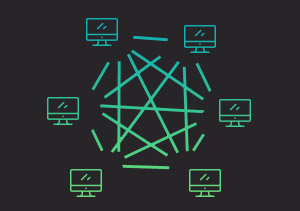The Decentralized System

decentralized system
The decentralized system, also known as the delocalized system, comes about when hardware and software components get allocated to an individual station.
Centralized systems, or localized systems, on the other hand, operate on the basis that most functions take place from a given remote location that is central to the others. Localized systems were standard back in the early days of computers when systems were unable to handle many commands at a time. Over time, the delocalized system has come to be a favorite, and it is not for naught. This concept comes with numerous benefits.
You see, the evolvement of computers has resulted in powerful desktops which can process many operations at a go. As such, the performance levels of these computers are so high that they end up more than exceeding the needs of many business applications. As a result of this, many such devices are underutilized as they spend most of their time idle, regarding what they can achieve if they were to get utilized to their full potentials. The basis of a delocalized system is to provide a means by which modern-day computers can get used to their full capacity and thus reduces the rate of idleness in these devices.
There is an ongoing contention as to whether this system has an impact on the overall efficiency in the workplace or not. You see, in a localized system, all computers can get updated with new programs from a particular point, and this reduces the amount of work involved in the process. In the case of delocalized systems, each computer must get updated with the new programs, as this activity cannot take place from a focal point.
However, these delocalized computers can still share files, thus enabling efficiency in the sharing of information. Users of this system can also share peripheral devices such as printers and scanners and therefore there is no requirement to incur enormous costs at the workplace. They can also share an internet connection with ease.
The delocalized system, therefore, consists of different computers in different stations which exist in the same network but are capable of running independently. In this way, if one computer fails to start up, the others do not get affected, and operations can continue as planned.
The peer to peer system
In this system, applications run on different computers in the delocalized system, and they connect to each other in the performance of given tasks. No central operating system exists to oversee the activities, and the computers can act independently of each other as none is subordinate to the other. The lack of a central system is not only time saving, but it also reduces the charges incurred in setting up such a system. An example of such a situation is in LAN messaging. Users of this platform need not have a central server for them to communicate.
Users can also share files among the computers without facing legal backlash as there is no central server involved in the process. Thanks to the growth of technology over the years, we can finally let go of localized systems and embrace the benefits that stem from decentralization.

